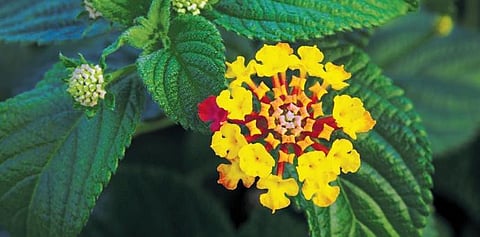

Ornamental attraction can be a disastrous one. The story of the invasive flowering plant Lantana Camara is one such. It is wreaking havoc in Karnataka’s forests and crops, calling for urgent steps to restrict its spread.
This plant has infested grazing lands, pastures, orchards and plantations like coffee, tea, cotton, coconut, oil palm, among others, while adversely compromising the economic viability of the crops.
This has a menacing bearing on other things. Forest, Environment and Ecology Minister Eshwar Khandre has pointed out that the menace has led to increasing man-animal conflict, with about 50% of the state’s forest landscape being infested with this invasive flowering species. Wild herbivores, and therefore carnivores too, are moving towards human habitats as Lantana-affected crops, on which they would have otherwise feasted, no longer attract them.
The plant is highly tolerant and adaptable, and as per one estimate, about 40% of the Western Ghats — 1.3 crore hectares — is covered by this plant species, heaping its harmful effects with its rapid spread and capability to overpower native species.
Belonging to the verbena family of flowering plants which are native to the American tropics, it was taken to Australia in the 1840s as an ornamental garden plant — obviously without knowing its harmful effects on native plants. It found its way into India in the following years, courtesy the British, where it revealed its highly invasive, toxic and fast-spreading features, marking its place among the world’s ten worst invasive plant species, and viewed as “species of high concern” in India. It alters the nutrient cycle of the soil, competes for resources and space with the native species of plants and crops, besides reducing the forage plants for wild herbivores.
The Lantana Camara has allelopathic qualities, which means it expresses a negative effect on the native plant species, limiting the latter’s productivity by producing chemicals that are harmful.
Even more of concern is that the Lantana Camara foliage directly harms animals — ruminants and non-ruminants — as it contains hepatotoxic pentacyclic triterpenoids called lantadenes, which can cause cholestasis (impacting flow of bile from liver to the digestive system) and hepatotoxicity (acute/chronic liver injury), while its fruits are highly toxic to humans, especially children from forest-dwelling communities who are more prone to biting into something that looks irresistibly edible without knowing its deadly effects.
Lantana Camara worsens the prevailing scenario of deforestation, which is already an issue needing to be addressed urgently. This invasive species has been playing its own role all by itself. Therefore the urgency to manage the crisis.
However, there is a silver lining. The same Lantana Camara provides huge opportunities for employment for not just the tribal communities, but also many others who can exploit this fast-growing invasive flowering to make artefact and articles of daily use, including furniture.
Khandre has said there are plans to set aside Rs 50 lakh to Rs one crore to provide assistance to tribals on clearing Lantana and supporting artisans in making and popularising Lantana products. The minister has sought support of industries and corporates in clearing Lantana plants and creating a demand-driven market for items made from Lantana Camara plants. The state forest department has been asked to provide assistance to the tribals in selling their Lantana products, too.
Years ago, the Bengaluru-based Institute of Wood Science and Technology (IWST) — a research institute under the Indian Council of Forestry Research and Education of the Union Ministry of Environment and Forests — had already begun showing the way to exploit Lantana Camara, making doors, windows, foot mats and smaller articles of use from the residues of this plant compressed into a composite material.
The methods and techniques are already transferred, and a few entrepreneurs are already at it — only that it needs to be popularised, so more, including potential tribal and other entrepreneurs, can benefit. It’s a win-win opportunity that needs to be pursued … to save our forests from this pest plant in the bargain.
Nirad Mudur
Deputy Resident Editor, Karnataka
niradgmudur@newindianexpress.com